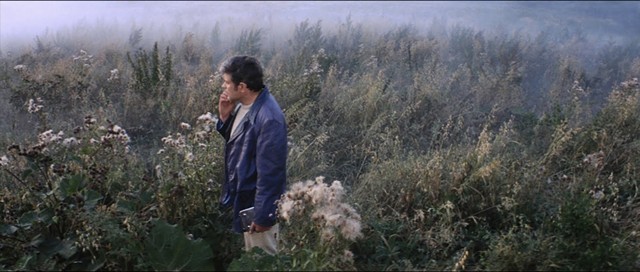
- Mosfilm
- A gorgeous earthly landscape in Solaris
Though both my wife and I were sort of lukewarm on the novel, I nevertheless declared that we’d be embarking on the Solaris Project, in which we would watch both film versions of the book: the 1972 version by Andrei Tarkovsky, and the 2002 remake by Steven Soderbergh. (I recently learned that the book was made into a Russian television movie in 1968, but I’m not sure that I’m enough of a completist to seek it out.) I’d seen them both before, but not for approximately 20 and 10 years, respectively. So I was looking forward to revisiting them, as I admire both directors, albeit for different reasons.
Though Lem and Tarkovsky evidently had differences of artistic opinion about turning the book into a film, I found the two texts to be pretty similar in artistic spirit. Both of them are heady affairs: contemplative, concerned with Big Issues such as the nature of humanity and consciousness, and composed of roughly equal proportions of narrative events and long, digressive passages that are expository and, seemingly, deliberately dull.
From what I gather, Lem was unhappy that his novel was altered at all, which seems like a silly hard-line stance to take. All texts are transformed when they are remade. Still, it seems to me that these two Solarises are more alike than different in tone, pacing and theme. Lem should have been pleased.
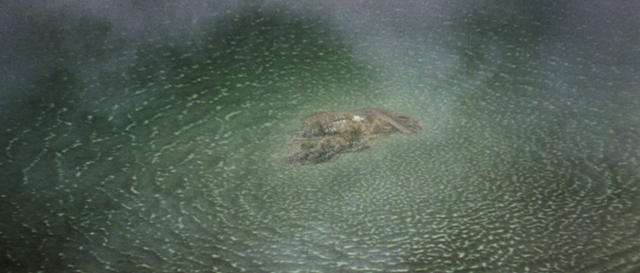
- Mosfilm
- Is this island on Earth? Solaris? Somewhere else?
Psychologist Kris Kelvin is sent to a space station that orbits Solaris to check on the health and scientific progress of the station’s skeleton crew. When he arrives, he finds that one of the three scientists has killed himself, and the other two have reached various levels of paranoia, confusion or megalomania. Both have been visited by strange and inexplicable beings — as solid and three-dimensional as the scientists themselves — that seem somehow to have been created ex nihilo by Solaris’ ocean.
Soon Kelvin himself is visited by such a being: his late wife (named Rheya in the novel, Hari in the film). He starts to fall in love with her again, but doing so causes him existential agony. Is she real? What is real? What is the nature of love, humanity, consciousness — life, even? At a certain point in both texts, it becomes difficult to discern what is actually happening.
I found myself fairly uninterested in the book’s, and the movie’s, meditations on the nature of human consciousness. Though I suppose both texts do raise potentially profound questions, those questions play, to me, a little like late-night, illicit-substance-fueled sessions in a college dorm room. The pondering of such imponderables is not the main attraction of fiction for me — and science fiction traffics in such stuff with far greater fervor than do most other genres.

- Mosfilm
- A lovely GIF of a teacup in the rain in Solaris
I have always studied and enjoyed art from a formalist perspective, meaning that the most exciting things to me are how its artist uses the creative tools and parameters that his or her medium affords. In reading a novel, I’m usually less interested in its story than I am in the prose style of the author; in film, I’m most interested in visual stylistics.
Tarkovsky’s films reward the viewer with a perspective like mine. I’m embarrassingly patchy in my knowledge of his work — I suppose I’ve seen only about half of his relatively small filmography. Every film of his that I’ve seen is, in one way or another, visually astonishing.
One of the first shots of the film (excerpted at the top of this post) is utterly ravishing. It starts by studying the vegetation near an earthly lake, and cranes and tilts upward to reveal Kris Kelvin standing in, then walking through, a misty meadow. It’s so beautiful as to be arresting; it also serves the thematic purpose of linking Earth and Solaris along the lines of mysterious aquatic systems.
But it’s on the space station, where most of the film takes place, that Tarkovsky busts out the most jaw-dropping shot compositions. In the still below, Tarkovsky plays wittily with basic geometric shapes — circles and rectangles — to achieve a composition that is both harmonious and askew. Note how the circular windows are echoed by the circular holes in the ceiling and, more playfully, by the weirdly shaped bottle on the floor. He also draws our attention to the “broken” nature of the silver rectangular column by contrasting it with the similarly colored and shaped lockbox at the right.
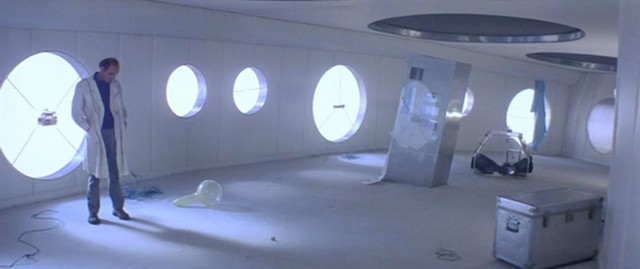
- Mosfilm
- Meticulous composition in Solaris
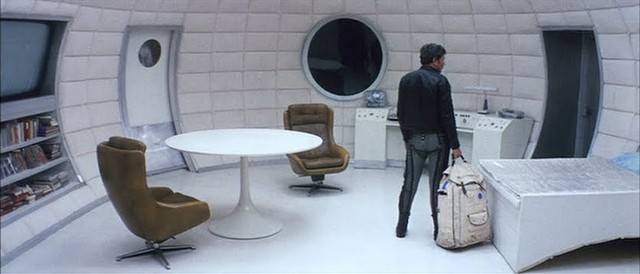
- Mosfilm
But the shots that stunned me most are the many that take place in the tubular hallways of the space station. The walls of these halls are lined with countless electronic consoles, all deep red and identical but for the lights that are illuminated (or not) on each one. I was so stunned by the beauty of this hallway set that I found myself failing to pay attention to the film’s story altogether in these scenes. That red is so lush, the repetition of the patterned consoles so pleasing to my eye.
Tarkovsky plays a game with viewers who, like me, get lost in this mise-en-scène: By including the tiniest of just-noticeable variations — mostly in the form of alternately illuminated lights — he entices us to look for meaning in these shots’ visual design. It’s a bit of a mean joke, because there is not much meaningful patterning here. The slight variations in the endless iterations of these consoles are simply indicative of the chaos into which this space station has been thrown. Doesn’t mean I ever stopped staring at those curved red walls, though.
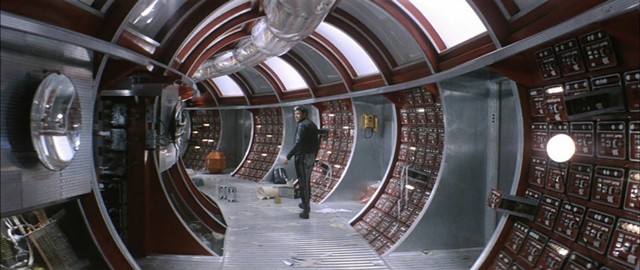
- Mosfilm
- The red hallway in the space station in Solaris
Speaking of...
-

A New Film Explores Vermont’s Unsung Modernist Buildings
Mar 20, 2024 -

A Film Critic Pays Final Respects to the Palace 9
Nov 11, 2023 -

Director Jay Craven Wins 10th Annual Herb Lockwood Prize
Oct 21, 2023 -

Book Review: 'Save Me a Seat! A Life With Movies,' Rick Winston
Aug 30, 2023 -

Steve MacQueen Named Executive Director of Vermont International Film Festival
May 22, 2023 - More »






Comments
Showing 1-1 of 1
Comments are closed.
From 2014-2020, Seven Days allowed readers to comment on all stories posted on our website. While we've appreciated the suggestions and insights, right now Seven Days is prioritizing our core mission — producing high-quality, responsible local journalism — over moderating online debates between readers.
To criticize, correct or praise our reporting, please send us a letter to the editor or send us a tip. We’ll check it out and report the results.
Online comments may return when we have better tech tools for managing them. Thanks for reading.